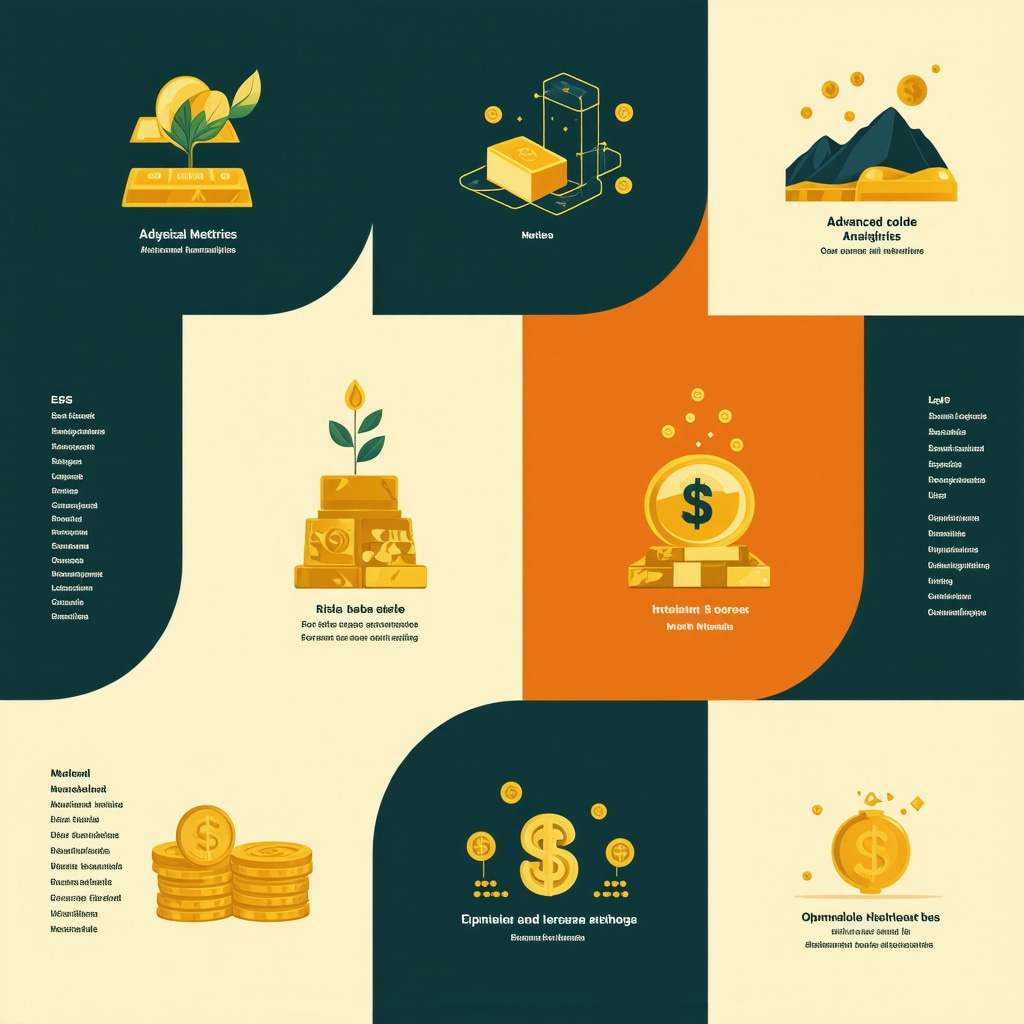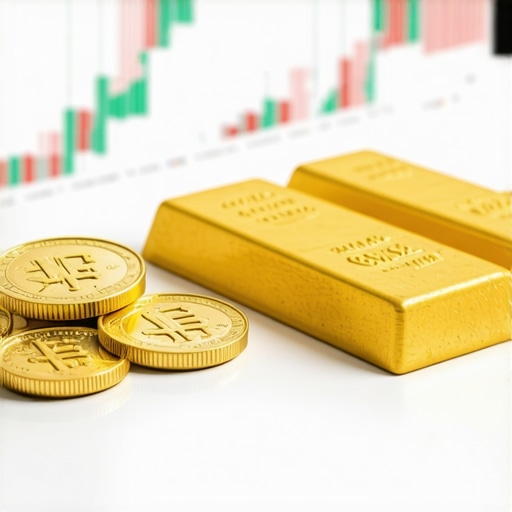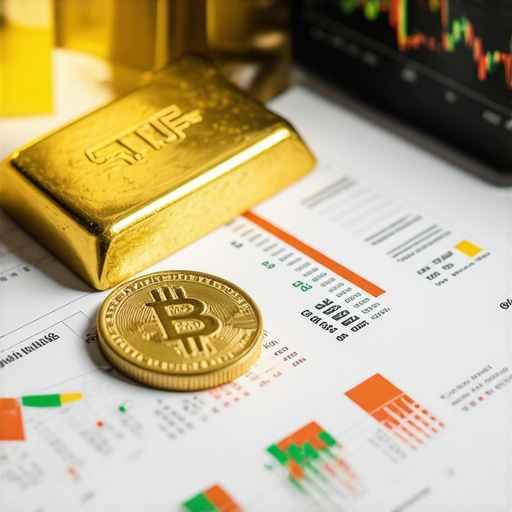Examining the Nuances Between Gold ETFs and Gold Stocks for Portfolio Diversification
In an investment landscape characterized by volatility and uncertainty, gold remains a pivotal asset for hedging risks and preserving wealth. However, discerning between gold exchange-traded funds (ETFs) and gold stocks involves a sophisticated understanding of their distinct risk-return profiles and market dynamics. This discourse explores the comparative advantages of Gold ETFs versus Gold Stocks, emphasizing advanced portfolio optimization techniques and macroeconomic sensitivities.
Structural and Market Mechanisms Underpinning Gold ETFs and Gold Stocks
Gold ETFs function as pooled investment vehicles that track the spot price of gold, offering investors direct exposure with high liquidity and relatively low management fees. In contrast, gold stocks represent equity stakes in companies engaged in gold mining or exploration, whose valuations are influenced not only by gold prices but also by operational efficiencies, geopolitical risks, and commodity extraction costs. This dual dependency introduces layers of volatility and potential alpha generation beyond bullion price movements.
How Do Gold ETFs and Gold Stocks Differ in Risk Exposure and Return Potential?
Gold ETFs provide a near-pure play on gold price fluctuations, minimizing idiosyncratic risks and offering a passive investment avenue aligned with bullion market trends. Conversely, gold stocks embed company-specific risks such as management quality, exploration success, and regulatory environment, which can magnify returns during bullish phases but amplify losses under adverse conditions. Investors seeking growth may prefer gold stocks for their leverage to operational performance, while those prioritizing capital preservation might lean towards gold ETFs for their stability and ease of diversification.
Integrating Gold Assets Within a Multi-Asset Portfolio: Strategic Considerations
From a portfolio theory perspective, the low correlation of gold ETFs with traditional equities and bonds enhances diversification benefits. Gold stocks, exhibiting higher beta relative to the equity market, introduce greater systemic risk but also potential for outperformance during commodity upswings. Tactical allocation decisions should therefore weigh the investor’s risk tolerance, investment horizon, and market outlook. Employing a combination of gold ETFs and select high-quality gold stocks can optimize the risk-return tradeoff while leveraging sector-specific growth opportunities.
Expert Insights and Empirical Evidence Supporting Asset Selection
Empirical studies in financial journals such as the CFA Institute’s Research Digest affirm that gold ETFs serve as effective inflation hedges and safe havens during economic downturns, whereas gold stocks tend to outperform during commodity bull markets but underperform in recessions. This nuanced understanding enables sophisticated investors to dynamically adjust their exposure based on macroeconomic indicators and commodity cycle analysis.
For readers interested in expanding their strategic knowledge, exploring comprehensive comparisons between gold ETFs and stocks can yield actionable insights for portfolio construction.
What Advanced Metrics Should Investors Use to Evaluate Gold Stocks Beyond Price Correlation?
Beyond price correlation analysis, investors should incorporate metrics such as mining cost per ounce, reserve life, geopolitical risk indices, and cash flow sustainability to assess gold stocks’ intrinsic value and resilience. Integrating environmental, social, and governance (ESG) factors also becomes increasingly critical, as regulatory frameworks evolve and investor preferences shift towards responsible mining practices.
Engage with our community of experts to share your perspectives on gold asset allocation strategies by visiting our discussion forums and contributing your insights.
Leveraging Quantitative Models to Optimize Gold Investment Portfolios
In 2025’s complex market environment, quantitative models such as factor analysis and machine learning algorithms are increasingly used to dissect the multifaceted drivers behind gold ETFs and gold stocks. These models enable investors to capture nuanced relationships between macroeconomic variables, gold price volatility, and operational metrics of mining companies. For example, multifactor regression models incorporating interest rates, currency fluctuations, and geopolitical risk indices can forecast performance differentials between gold ETFs and stocks with enhanced precision.
Moreover, scenario analysis frameworks simulate the impacts of economic shocks and inflationary pressures on gold-related assets, allowing portfolio managers to stress-test allocation strategies rigorously. Integrating such data-driven methodologies facilitates dynamic portfolio rebalancing, optimizing risk-adjusted returns while mitigating downside exposure.
Environmental, Social, and Governance (ESG) Considerations in Gold Stock Selection
As sustainability becomes a paramount concern, ESG criteria have emerged as critical filters in selecting gold stocks. Investors now evaluate mining companies based on their environmental stewardship, labor practices, and governance transparency. These factors not only influence regulatory compliance and reputational risk but also affect long-term operational viability.
ESG screening can serve as a proxy for management quality and risk mitigation capacity. Companies with robust ESG scores often demonstrate better resource management, lower litigation risks, and stronger community relations, which may translate into more stable cash flows and potentially superior stock performance over time. Consequently, incorporating ESG metrics into gold stock analysis complements traditional financial and operational evaluations.
How Can Advanced Risk Metrics and ESG Integration Transform Gold Stock Investment Strategies?
Utilizing advanced risk metrics such as Value at Risk (VaR), Conditional VaR, and stress-testing in conjunction with ESG integration allows for a holistic assessment of gold stocks’ risk-return profiles. This approach identifies vulnerabilities to systemic shocks and sustainability risks, enabling investors to construct more resilient portfolios. For instance, combining ESG scores with volatility measures and mining cost analyses can expose hidden risks or opportunities overlooked by conventional metrics.
Research by Morningstar highlights that funds integrating ESG factors in precious metals investments have demonstrated competitive or superior risk-adjusted returns compared to traditional counterparts, underscoring the practical benefits of this multidimensional analysis (Morningstar ESG Report, 2023).
Pragmatic Approaches to Physical Gold Storage and Security in 2025
While digital and paper-based gold instruments offer liquidity and convenience, physical gold remains a cornerstone for many investors seeking tangible asset security. Effective storage solutions involve a balance between accessibility, security, and insurance coverage. Options range from home safes with advanced biometric locks to bank safety deposit boxes and specialized third-party vault services.
Emerging technologies such as blockchain-based ownership verification and smart vaults are revolutionizing physical gold custody, providing enhanced transparency and reducing counterparty risks. Investors must diligently evaluate storage providers’ reputation, regulatory compliance, and insurance policies to safeguard their holdings effectively.
For a detailed guide on securing physical gold investments, readers can consult How to Safely Store Physical Gold: Essential Tips for Investors.
We invite you to share your experiences with gold asset allocation and storage strategies in the comments below. Engaging in this dialogue enriches collective expertise and empowers smarter investment decisions.

Revolutionizing Gold Portfolio Management with Machine Learning and AI-Driven Insights
In the evolving landscape of gold investment, artificial intelligence (AI) and machine learning (ML) applications have transcended traditional analytics, offering unparalleled predictive accuracy and risk mitigation capabilities. By incorporating vast datasets—including macroeconomic indicators, geopolitical events, and historical price behavior—ML algorithms can detect subtle nonlinear patterns and regime shifts that human analysts might overlook.
For instance, reinforcement learning models dynamically adjust portfolio weightings between gold ETFs and stocks by continuously learning from market feedback loops. This adaptive approach enhances the ability to capture alpha in volatile environments while optimizing drawdown controls. Moreover, natural language processing (NLP) tools parse global news and social sentiment to anticipate sudden market shocks impacting gold asset valuations.
These AI-driven tools enable a hyper-responsive investment framework, far surpassing traditional factor models. Investors equipped with such technology are poised to capitalize on emerging trends and nuanced risk factors with greater precision.
What Are the Challenges and Best Practices in Implementing AI for Gold Asset Allocation?
Implementing AI models in gold investment requires rigorous data curation, model validation, and interpretability considerations to avoid overfitting and ensure robustness. The scarcity of high-quality, labeled data on mining operations and geopolitical risk indices often limits model efficacy. Additionally, black-box AI models may face skepticism from regulatory bodies and institutional stakeholders demanding transparency.
Best practices involve hybrid frameworks combining domain expertise with algorithmic insights, incorporating explainable AI (XAI) techniques to elucidate model decisions. Regular backtesting against diverse market scenarios and stress tests are imperative to validate model stability. Collaborating with interdisciplinary teams—quantitative analysts, ESG experts, and geostrategic analysts—further enriches the model’s contextual relevance.
As emphasized by Journal of Finance (2023), the fusion of AI with fundamental analysis represents the frontier of quantitative asset management.
Integrating Blockchain Technology for Enhanced Transparency and Security in Gold Investments
Blockchain offers transformative potential for gold investors by enabling immutable, transparent records of ownership and provenance. Tokenization of physical gold assets on blockchain platforms facilitates fractional ownership, increases liquidity, and reduces counterparty risks associated with traditional custodial arrangements.
This technology also streamlines compliance with anti-money laundering (AML) and know-your-customer (KYC) regulations, as transactions are traceable and verifiable in real time. Smart contracts automate settlement and dividend distribution for gold stockholders, enhancing operational efficiency.
Furthermore, blockchain-based ESG certifications provide verifiable proof of responsible mining practices, addressing investor demand for sustainable asset allocation.
How Does Blockchain Tokenization Impact Gold Market Accessibility and Investor Protection?
Tokenization democratizes access to gold investments by lowering minimum entry thresholds and enabling instant trading on digital exchanges. This inclusivity opens new avenues for retail investors and institutional players seeking diversified exposure without the logistical challenges of physical gold custody.
However, regulatory frameworks are still evolving, and investors must exercise due diligence regarding platform security, token issuer credibility, and legal enforceability of digital asset ownership. Collaborating with regulated entities and leveraging third-party audits are essential safeguards.
The World Gold Council highlights blockchain’s role in enhancing market integrity and investor confidence in its 2024 report on Blockchain and Gold Market Innovation.
Advanced Scenario Analysis: Navigating Gold Investments Amid Geopolitical and Economic Uncertainties
Given gold’s status as a safe haven, its price dynamics are intricately linked with geopolitical tensions, monetary policy shifts, and inflationary pressures. Sophisticated scenario analysis tools simulate multi-dimensional shocks—such as supply chain disruptions, interest rate hikes, or trade embargoes—to forecast gold ETFs and gold stocks’ performance under diverse conditions.
Combining Monte Carlo simulations with machine learning-driven stress testing enables portfolio managers to anticipate tail risks and optimize hedging strategies proactively. This granular approach surpasses conventional sensitivity analyses by modeling complex interdependencies and temporal correlations.
Such forward-looking analytics empower investors to reallocate assets dynamically, balancing growth opportunities against downside protection in an unpredictable global environment.
Explore our repository of expert analyses and leverage cutting-edge tools to refine your gold investment strategies—join our community today to exchange insights with industry leaders.
Decoding the Symbiosis of AI and Blockchain in Modern Gold Asset Management
As the investment landscape evolves, the convergence of artificial intelligence (AI) and blockchain technology emerges as a paradigm shift in managing gold portfolios. This fusion enables unparalleled transparency, predictive analytics, and operational efficiency, transforming traditional gold asset allocation from reactive to anticipatory frameworks.
AI’s prowess in processing vast datasets—from macroeconomic indicators to real-time geopolitical cues—coupled with blockchain’s immutable ledger for gold provenance and ownership, paves the way for a new era of trust and agility in gold investments. These technologies not only mitigate systemic risks but also unlock novel avenues for fractional ownership and enhanced liquidity.
What Are the Cutting-Edge AI Techniques Enhancing Predictive Accuracy in Gold Market Forecasting?
Advanced AI methodologies, such as ensemble learning and deep reinforcement learning, are at the forefront of gold market analytics. Ensemble models synergize multiple predictive algorithms to reduce variance and bias, yielding robust forecasts under volatile conditions. Deep reinforcement learning agents adaptively optimize portfolio rebalancing strategies by learning from market feedback loops, inherently adjusting to regime shifts and macroeconomic shocks.
Moreover, natural language processing (NLP) techniques analyze sentiment from diverse sources including financial news, social media, and policy announcements to anticipate market sentiment shifts impacting gold valuations. Integrating these multilayered AI insights allows investors to anticipate price inflection points with enhanced granularity.
Blockchain-Driven Tokenization: Democratizing Gold Investment While Fortifying Security
Tokenization on blockchain platforms fractionalizes physical gold assets into digital tokens, enabling investors to participate with lower capital thresholds and real-time liquidity. This democratization broadens access beyond traditional institutional domains, fostering inclusivity.
Furthermore, blockchain’s cryptographic security ensures provenance authenticity and transaction immutability, critical for combating fraud and counterfeit risks prevalent in physical gold markets. Smart contracts automate compliance protocols and dividend distributions, streamlining operational overhead and reducing counterparty risk.
Synergizing Quantitative AI Models with ESG Integration for Sustainable Gold Investment Excellence
Incorporating ESG metrics alongside AI-driven quantitative models refines the evaluation of gold stocks by embedding sustainability and governance parameters into risk-return analyses. AI algorithms can process ESG datasets, mining operational data, and geopolitical risk indices simultaneously to identify companies demonstrating superior resilience and ethical practices.
This multidimensional approach aligns investment performance with long-term sustainability, catering to the growing demand for responsible investing without compromising returns.
How Can Investors Effectively Navigate the Regulatory and Ethical Complexities of AI and Blockchain in Gold Investments?
Deploying AI and blockchain in gold investment necessitates rigorous compliance with emerging regulatory frameworks governing data privacy, algorithmic transparency, and digital asset custody. Investors must prioritize platforms and service providers adhering to global standards such as GDPR, MiCA, and FATF recommendations.
Ethically, ensuring explainability in AI decisions mitigates black-box risks, while blockchain’s transparent audit trails support regulatory reporting and anti-fraud measures. Engaging multidisciplinary expertise—from legal, technological, and financial domains—fortifies adherence to governance and ethical mandates.
As highlighted by the CFA Institute Research Digest (2024), the judicious integration of AI and blockchain technologies is pivotal for future-proofing gold portfolio management amid escalating complexity.
Engage with the Frontier of Gold Investment Innovation
Harnessing the synergy of AI and blockchain technologies transcends conventional gold investment paradigms, offering a sophisticated toolkit for predictive precision, enhanced security, and sustainable portfolio construction. We invite you to delve deeper into these transformative methodologies and participate in our expert forums, where pioneering investors and technologists converge to shape the future of gold asset management.
Expert Insights & Advanced Considerations
Gold ETFs Offer Precision Hedging Amid Macroeconomic Volatility
For investors prioritizing inflation protection and portfolio stability, gold ETFs deliver near-direct exposure to bullion prices with minimal operational risks. Their liquidity and low-cost structure make them ideal instruments for tactical asset allocation adjustments in response to shifting macroeconomic indicators.
Gold Stocks Provide Leveraged Exposure but Demand Rigorous Fundamental Analysis
Equity investments in gold mining companies are inherently more volatile due to operational, geopolitical, and ESG factors. However, when evaluated through advanced metrics such as mine cost efficiency, reserve longevity, and governance quality, gold stocks can significantly outperform during commodity upcycles, rewarding diligent due diligence.
Integrating AI and Blockchain Technologies Elevates Portfolio Management Precision
The fusion of AI-driven analytics with blockchain-enabled transparency is reshaping gold asset allocation. Machine learning models enhance predictive accuracy for both ETFs and stocks, while blockchain tokenization democratizes access and fortifies security, collectively enabling more responsive and resilient investment strategies.
ESG Integration Is No Longer Optional but a Strategic Imperative in Gold Stock Selection
Robust ESG criteria now serve as critical risk mitigants, influencing long-term operational sustainability and regulatory compliance. Incorporating ESG analysis alongside quantitative financial metrics uncovers hidden risks and opportunities, aligning gold investments with evolving investor values and market expectations.
Scenario and Stress Testing Models Are Essential for Navigating Geopolitical and Economic Uncertainties
Dynamic scenario analysis frameworks, enhanced by Monte Carlo simulations and reinforcement learning, provide a granular understanding of tail risks affecting gold ETFs and stocks. These tools empower investors to proactively rebalance portfolios, optimizing risk-adjusted returns amid complex global conditions.
Curated Expert Resources
- CFA Institute Research Digest: Offers peer-reviewed, cutting-edge studies on gold asset performance, ESG integration, and AI applications in asset management (CFA Digest).
- Morningstar ESG Report 2023: Provides empirical evidence and analysis on the impact of ESG factors within precious metals investing, underscoring risk-adjusted benefits (Morningstar ESG Report).
- World Gold Council Blockchain and Gold Market Innovation: Explores blockchain’s transformative role in gold provenance, tokenization, and compliance (World Gold Council Report).
- Journal of Finance (2023): Features authoritative research on AI-driven quantitative investing, including applications to commodity markets (Journal of Finance).
- BuyingGoldNow Comprehensive Guides: Extensive, practical resources such as comparing gold ETFs and stocks and physical gold storage strategies provide actionable insights for investors.
Final Expert Perspective
Distinguishing between gold ETFs and gold stocks requires a sophisticated synthesis of market dynamics, operational fundamentals, and emerging technologies. Gold ETFs excel in providing liquidity and inflation-hedging precision, while gold stocks offer alpha potential conditioned on rigorous ESG and operational analyses. The integration of AI and blockchain technologies not only enhances predictive capabilities but also democratizes and secures gold investment avenues. Moving forward, investors who leverage advanced scenario modeling and embrace sustainability criteria will be best positioned to navigate the evolving gold investment landscape with confidence and strategic foresight.
To deepen your mastery of gold asset allocation, consider exploring our expert articles on comparing gold ETFs and stocks and physical gold storage. Engage with our professional community to exchange insights and refine your strategies for 2025 and beyond.









